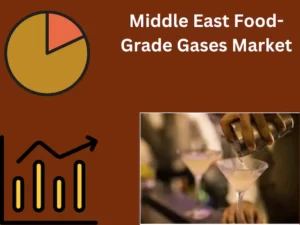
- Published 2024
- No of Pages: 200
- 20% Customization available
Middle East Food-Grade Gases Market Research Report, Analysis and Forecast
Middle East Food-Grade Gases Market Synopsis
Gases that are acceptable for consumption are known as “food-grade gases,” and they are employed in the preparation and packing of food to preserve its quality, safety, and freshness. Due to their efficiency and safety in food preservation, these gases are frequently utilised in the Middle Eastern food business, and their use is increasing.

An essential component of the Middle Eastern food sector is the use of food-grade gases in food processing and packaging. These gases are employed to alter the environment inside packaging, manage bacterial development, and lengthen the shelf life of food products. Oxygen, nitrogen, and carbon dioxide are a few of the gases that are most frequently employed in food-grade products.
One of the main reasons for the growing popularity of food-grade gases in the Middle East is their ability to preserve the quality and freshness of food products for longer periods. This is especially important in a region where temperatures can be high and food spoilage can be a significant issue. By using food-grade gases, food manufacturers can extend the shelf life of their products without adding any chemical preservatives.
Middle East Food-Grade Gases are used in the production of frozen, canned and packaged foods, as well as baked goods.
Carbon dioxide, nitrogen, oxygen and hydrogen are the most commonly used food-grade gases in the Middle East.
Carbon dioxide is used in the production of carbonated beverages and as a propellant in aerosol containers.
The Middle East is the world’s largest producer of crude oil, and rising oil refinement activities are promoting the use of food-grade gases in the region.
Nitrogen is used to create an inert atmosphere, which prevents spoilage and oxidation of food.
Oxygen is used to help maintain the freshness of food and to help preserve colour, flavour and texture.
Hydrogen is used in the production of hydrogenated oils and fats.
Additionally, food-grade gases are safe for use in food products and do not leave any residue or affect the taste or smell of the food. They are also cost-effective compared to other preservation methods, making them a popular choice among food manufacturers.
Overall, the use of food-grade gases is becoming increasingly important in the Middle East food industry. With their ability to preserve the quality and safety of food products, while also being safe and cost-effective, their popularity will likely continue to grow in the future.
Middle East Food-Grade Gases Market: Overview
Food-grade gases refer to the gases that are used in the food and beverage industry to maintain the quality, freshness, and safety of food products. Nitrogen, oxygen, and carbon dioxide are the most commonly used food-grade gases in the industry.
Nitrogen is used for a variety of purposes such as freezing and chilling food products, pressurizing and dispensing beer and other beverages, and packaging food products such as potato chips, nuts, and coffee. It helps to prevent the oxidation of food products, thereby increasing their shelf life.
Oxygen is primarily used in the food and beverage industry for modified atmosphere packaging (MAP). It helps to preserve the colour, texture, and flavour of fresh food products such as meat, poultry, and fish. It is also used for aerobic fermentation in the production of cheese, yoghurt, and other fermented dairy products.
Carbon dioxide is widely used for the carbonation of soft drinks, beer, and other beverages. It also helps to prevent the growth of bacteria and other microorganisms in packaged food products.
Food-grade gases are used for various applications such as freezing and chilling, packaging, and carbonation. Freezing and chilling food products using nitrogen helps to preserve the freshness and quality of the products. Packaging of food products using nitrogen, oxygen, or carbon dioxide helps to extend their shelf life and prevent spoilage. Carbon dioxide is used for the carbonation of soft drinks, beer, and other beverages, which gives them the desired fizz and taste.
Overall, the use of food-grade gases is becoming increasingly popular in the Middle East due to the growing demand for packaged food products, beverages, and frozen foods. The use of these gases helps to ensure the safety, freshness, and quality of the products, thereby increasing their shelf life and enhancing their appeal to consumers.
Saudi Arabia Food-Grade Gases Market Synopsis
The food-grade gas market in Saudi Arabia is growing due to the increasing demand for fresh and frozen food products in the region. With a growing population and a large number of tourists and expatriates, there is an increased demand for quality food products. This has led to the growth of food-grade gas production in the region, as it is used to store, preserve, and transport these foods. Additionally, the Saudi government is encouraging the use of food-grade gas for food processing, storage, and transportation to ensure food safety. The government is also investing in research and development to improve the production of food-grade gases to meet the increasing demand.
UAE Food-Grade Gases Market Synopsis
The food-grade gas market in the UAE is growing due to the increasing demand for frozen and fresh food products in the region. With the increasing number of tourists and expatriates, the demand for quality food products has increased. This has led to the growth of food-grade gas production in the region, as it is used to store, preserve, and transport these foods. Additionally, the UAE government has implemented numerous initiatives to promote the use of food-grade gas for food processing, storage, and transportation to ensure food safety. The government is also investing in research and development to improve the production of food-grade gases to meet the increasing demand.
Middle East Food-Grade Gases Market: Segmentation
The middle east Baby Care Products market has been segmented By Type and By Application.
Based on the By Type, the middle east is Nitrogen, Oxygen, and Carbon Dioxide. In 2021, carbon dioxide held a significant share. Carbon dioxide (CO2) is a food-grade gas commonly used in the food industry for applications such as carbonation, modified atmosphere packaging, and freezing. It also acts as a preservative and extends shelf life. In 2021, carbon dioxide held a significant share of the food-grade gases market due to its wide range of applications and low cost. Additionally, carbon dioxide is an environmentally friendly and non-toxic gas, making it a preferred choice for food production processes. For instance, carbon dioxide is used in food-grade applications as a packaging gas to displace oxygen to reduce spoilage and prevent microbial growth inside packages.
Based on the By Application, the middle east is Freezing & Chilling, Packaging, and Carbonation. In 2021, the Freezing & Chilling segment held a significant share. Freezing & chilling food-grade gases are used in food processing and preservation, to maintain food freshness and quality while extending shelf life. They are also used to reduce food contamination and spoilage. Moreover, these food-grade gases also provide a cost-effective way to safely produce, store, and transport food products. The increasing demand for convenience and ready-to-eat food products has resulted in the need for food-grade gases that can be used to quick-freeze and chill food products. Additionally, the growing demand for food safety and quality has driven the need for food-grade freezing and chilling gases, as they are more effective at preserving food than traditional methods
In 2021, the Middle East Food-Grade Gases space saw several significant developments.
- In January 2021, the UAE-based firm, Neutron Industries, announced a new merger with the Jordanian company, Al-Qasim Gases, to create a new food-grade gas company in the Middle East.
- In April 2021, the Saudi Arabian firm, KF-Gas, announced the launch of a new line of food-grade gases in the Middle East.
- In 2021, Praxair, a leading supplier of food-grade gases in the Middle East, announced the launch of its newest product line of oxygen, nitrogen, and carbon dioxide (CO2) gases specifically designed for food-grade applications. This product line is designed to meet the highest quality standards and provide customers with a reliable source of food-grade gases for their production needs. The new product line will include both food-grade and industrial-grade gases, and Praxair is investing heavily in research and development to ensure its safety and quality.
In 2021, there were several acquisitions in the Middle East Food-Grade Gases company space.
- In February 2022, the UAE-based gas company, Air Liquide, acquired the Middle East’s largest Food Grade Gases company, Al Safwa Gas. The deal was announced to be worth more than $200 million and is expected to benefit both companies in terms of growth and market penetration.
- In June 2022, Qatar-based Al-Udeid Gas Company announced the acquisition of a UAE-based food grade gas firm. The acquisition will bolster Al-Udeid’s presence in the food grade gas market in the Middle East and provide them with access to a wider array of food grade gases. The acquisition will give Al-Udeid access to a greater number of customers, as well as a larger production capacity. This will allow them to better meet the demand for food grade gases in the Middle East. The acquisition will also open up new markets for Al-Udeid, as the acquired firm had a presence in several countries in the region.
The Middle East Food-Grade Gases Market is segmented as follows:
By Type
- Nitrogen
- Oxygen
- Carbon Dioxide
By Application
- Freezing & Chilling
- Packaging
- Carbonation
By Region
- The Middle East
- Saudi Arabia
- UAE
- Qatar
- Kuwait
- Oman
- Rest of the Middle East
“Every Organization is different and so are their requirements”- Datavagyanik
Companies We Work With






Do You Want To Boost Your Business?
drop us a line and keep in touch

